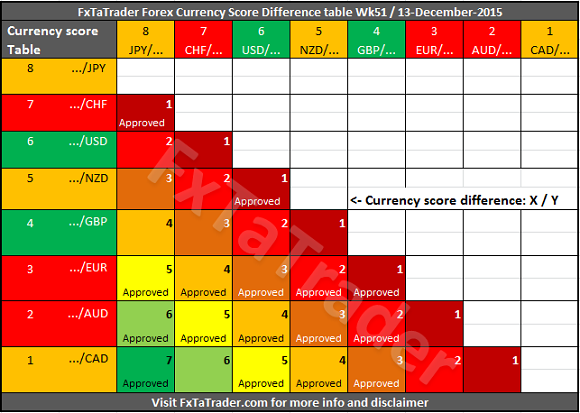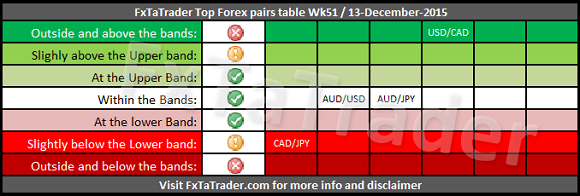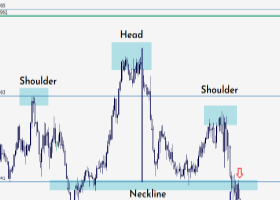Forex Currency Score Difference for Week 51 / 13-December-2015
13 December 2015, 17:38
0
45
The Currency Score Difference
analysis is the more extensive explanation on the Currency score
analysis which was published earlier this weekend. Besides these
analyses and the corresponding charts I also provide the Forex ranking
and rating list.
It is recommended to read the page Currency score explained and Models in practice for a better understanding of the article. This article will provide my analysis on the 8 major currencies based on the technical analysis charts using the MACD and Ichimoku indicator on 4 time frames: the monthly, weekly, daily and 4 hours. The result of the technical analysis is the 2 screenshots in this article showing the Currency Score Difference and the Top Forex pairs table.
In the previous article the analysis was made for the Currency Score and a summary of the results are here below:
According to the Ranking and Rating list already published this weekend
the following pair combinations look interesting:
The technical analysis is the most important issue to consider before
taking positions, the Weekly Chart is analyzed. I prefer the Bollinger
Band for defining where a pair is in the chart. Once a pair is outside
a Bollinger Band it is in a strong trend which can cause a strong
pullback. Although this may be a good opportunity I avoid taking
positions because of the possible unexpected strong pullback. Positions
are only opened inside the Bollinger Band and this may be at the start
of a possible trend or on a good pullback in an existing trend.
The following table shows the location related to the Bollinger Bands of each interesting pair analyzed and approved in all the previous analyses.
When trading according to the FxTaTrader Strategy some
rules are in
place. For more information
see the page on my blog FxTaTrader Strategy.
Depending on the opportunities that may
come up the decision to trade a
currency may become more obvious at that moment. If you would like to
use this article then mention the source
by
providing the URL FxTaTrader.com
or the direct link to this article. Good luck in the coming week.
DISCLAIMER: The
articles are my personal opinion, not recommendations, FX trading is
risky and not suitable for everyone.The content is for educational
purposes only and is aimed solely for the use by ‘experienced’ traders
in the FOREX market as the contents are intended to be understood by
professional users who are fully aware of the inherent risks in forex
trading. The content is for 'Forex Trading Journal' purpose only.
Nothing should be construed as recommendation to purchase any financial
instruments. The choice and risk is always yours. Thank you.
It is recommended to read the page Currency score explained and Models in practice for a better understanding of the article. This article will provide my analysis on the 8 major currencies based on the technical analysis charts using the MACD and Ichimoku indicator on 4 time frames: the monthly, weekly, daily and 4 hours. The result of the technical analysis is the 2 screenshots in this article showing the Currency Score Difference and the Top Forex pairs table.
In the previous article the analysis was made for the Currency Score and a summary of the results are here below:
- The CAD has a score at the moment of a weak currency and it seems best for trading going short against the strong currencies.
- The JPY has a score at the moment of a strong currency and it seems best for trading going long against the weak currencies
- There is a pullback for the USD, GBP and CHF.
- The other currencies, the EUR, AUD and the NZD, are within their range.
- Most of the interesting pairs from the "Ranking and Rating list" do also look interesting according to the "Currency Score" analysis from the previous article except for the CAD/JPY.
- The CAD/JPY is a pair having average currencies but depending on the Currency Score Difference it appears to be an interesting pair.
______________________________________
Currency
Score difference
- CAD/JPY with the AUD/USD
- AUD/JPY with the USD/CAD

______________________________________
The following table shows the location related to the Bollinger Bands of each interesting pair analyzed and approved in all the previous analyses.
- The pairs located within the Bollinger Bands and at the Bollinger Bands have the best opportunities because the chance of a pullback is the lowest.
- Any pair slightly above or below the Bollinger Bands may be inside when trading starts again. These pairs have to be checked on opening of the market.

______________________________________
______________________________________


